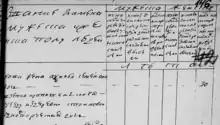Ksi (Cyrillic)
Ksi (Ѯ, ѯ) is a letter of the early Cyrillic alphabet, derived from the Greek letter Xi (Ξ, ξ). It was mainly used in Greek loanwords, especially words relating to the Church.
| Cyrillic letter Ksi | |||||||||||||||||||||||||||||||||||||||||||||||||||||||||||||||||||||||||||||||||||||||||||||||||||||||||||||||||||||||||||||||
|---|---|---|---|---|---|---|---|---|---|---|---|---|---|---|---|---|---|---|---|---|---|---|---|---|---|---|---|---|---|---|---|---|---|---|---|---|---|---|---|---|---|---|---|---|---|---|---|---|---|---|---|---|---|---|---|---|---|---|---|---|---|---|---|---|---|---|---|---|---|---|---|---|---|---|---|---|---|---|---|---|---|---|---|---|---|---|---|---|---|---|---|---|---|---|---|---|---|---|---|---|---|---|---|---|---|---|---|---|---|---|---|---|---|---|---|---|---|---|---|---|---|---|---|---|---|---|---|
 | |||||||||||||||||||||||||||||||||||||||||||||||||||||||||||||||||||||||||||||||||||||||||||||||||||||||||||||||||||||||||||||||
| Numeric value: | 60 | ||||||||||||||||||||||||||||||||||||||||||||||||||||||||||||||||||||||||||||||||||||||||||||||||||||||||||||||||||||||||||||||
| Derived from: | Greek letter Xi (Ξ ξ) | ||||||||||||||||||||||||||||||||||||||||||||||||||||||||||||||||||||||||||||||||||||||||||||||||||||||||||||||||||||||||||||||
| The Cyrillic script | |||||||||||||||||||||||||||||||||||||||||||||||||||||||||||||||||||||||||||||||||||||||||||||||||||||||||||||||||||||||||||||||
| Slavic letters | |||||||||||||||||||||||||||||||||||||||||||||||||||||||||||||||||||||||||||||||||||||||||||||||||||||||||||||||||||||||||||||||
| |||||||||||||||||||||||||||||||||||||||||||||||||||||||||||||||||||||||||||||||||||||||||||||||||||||||||||||||||||||||||||||||
| Non-Slavic letters | |||||||||||||||||||||||||||||||||||||||||||||||||||||||||||||||||||||||||||||||||||||||||||||||||||||||||||||||||||||||||||||||
| |||||||||||||||||||||||||||||||||||||||||||||||||||||||||||||||||||||||||||||||||||||||||||||||||||||||||||||||||||||||||||||||
| Archaic letters | |||||||||||||||||||||||||||||||||||||||||||||||||||||||||||||||||||||||||||||||||||||||||||||||||||||||||||||||||||||||||||||||
| |||||||||||||||||||||||||||||||||||||||||||||||||||||||||||||||||||||||||||||||||||||||||||||||||||||||||||||||||||||||||||||||

An example of the use of Ksi after it was formally abolished: a civil census 1782 (GATO, f. 389, cat. 1, case 2, p. 146)
Ksi was eliminated from the Russian alphabet along with psi, omega, and yus in the Civil Script of 1708 (Peter the Great's Grazhdanka), and has also been dropped from other secular languages. It was briefly restored in 1710 and ultimately removed in 1735. While it was no longer used in typographic fonts, it continued to be used by the church, and since clergy actively participated in civil censuses, Ksi can be found in multiple handwritten civil texts all the way until the early 1800s.
It represented "60" if used as a number.[1]
Computing codes
| Preview | Ѯ | ѯ | ||
|---|---|---|---|---|
| Unicode name | CYRILLIC CAPITAL LETTER KSI | CYRILLIC SMALL LETTER KSI | ||
| Encodings | decimal | hex | dec | hex |
| Unicode | 1134 | U+046E | 1135 | U+046F |
| UTF-8 | 209 174 | D1 AE | 209 175 | D1 AF |
| Numeric character reference | Ѯ | Ѯ | ѯ | ѯ |
This article is issued from Wikipedia. The text is licensed under Creative Commons - Attribution - Sharealike. Additional terms may apply for the media files.